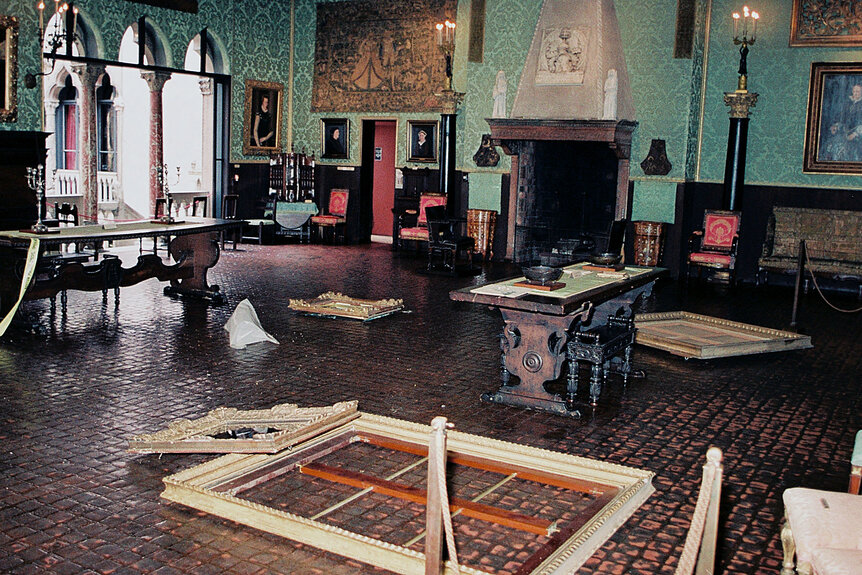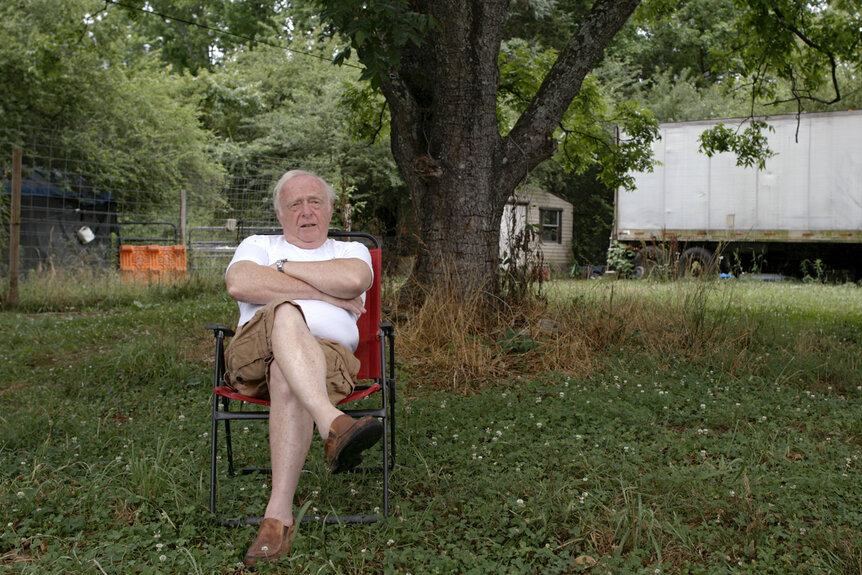Create a free profile to get unlimited access to exclusive videos, breaking news, sweepstakes, and more!
Top Theories Behind The World’s Largest Art Heist, Documented In ‘This Is A Robbery’
Following a $200 million art heist from the Gardner Museum in Boston in 1990, numerous theories arose, but the truth remains elusive.

Everything about the heist was audacious: In the early morning hours of March 18, 1990 security guards buzzed two thieves disguised as police officers into Boston’s Isabella Stewart Gardner Museum. Once inside, the men, armed with pistols, tied up the guards and spent 81 minutes methodically looting the museum. They made off with 13 pieces of art including works by Degas, Rembrandt, and Vermeer. At the time, the estimated value of their haul was $200 million. The case, believed to be the world’s largest art heist, was never solved. To this day, more than 30 years later, speculation and theories about what happened to the missing masterpieces, and who stole them, abounds.
The daring crime is revisited in Netflix’s new docuseries “This is a Robbery: The World’s Biggest Art Heist,” which hitsthe streaming service on Wednesday.
While the world may never know what actually transpired during that fateful day in art history, we have gathered up a few of the most famous theories:
An inside job
The amount of time spent in the museum, the apparent knowledge of where the desired art was, and the fact that surveillance footage was removed, has led some theorists to believe it was an inside job.
Rick Abath was one of the two guards who was duct-taped and handcuffed during the heist. The then-23-year-old music school dropout, who regularly showed up to work high, had apparently buzzed in a figure captured on surveillance footage the night before the robbery, the Boston Globe reported in 2017. He let them in through the same door he later unlocked for the thieves.
The docuseries points out that the thieves left an empty frame on the chair of the museum’s security director. Abath and the director didn’t get along and the young guard had recently put in his notice. Additionally, he opened a back door minutes before the two armed men arrived.. He told investigators that opening the door was common practice for him. However, that claim has never been corroborated.
Abath was a suspect early on, though he’s always maintained that he had nothing to do with the heist. He never returned to his job at the museum and was questioned extensively by the FBI. In 2013, he told the Boston Globe that a federal investigator had told him just a few years prior that they were never able to eliminate him as a suspect.
Rob Fisher, the assistant U.S. attorney in charge of the Gardner investigation from 2010 to 2016, says in the docuseries that it’s hard for him to believe that the suspects didn’t have prior knowledge that they’d be allowed in. The door they used to gain entry was essentially a “man-trap,” he noted, with two sets of doors they needed to be buzzed through separately. If the guards found someone suspicious, they could have held them indefinitely and securely between the two doors.
Art thief and musician Myles Connor
The docuseries also dives into the theory that art thief Myles Connor had something to do with the heist. A colorful former rock-n-roll performer, with a a baby leopard and a parrot, Connor also has a history of art theft.
“Some people consider me the biggest art thief in the country because I robbed a number of museums,” Connor says in the docuseries.
He had been conducting art heists since the 1960s, including stealing a Rembrandt from Boston’s Museum of Fine Arts in 1975. While he admitted to casing the Gardner, he was behind bars during the 1990 heist. However, that has not stopped rumors and theories that he had some involvement in the heist.
Connor is also the son of a police officer, and a member of Mensa, a society reserved for people with high IQs. He had convictions for selling cocaine as well as a shocking 1981 conviction for murdering two women in Quincy. However, that verdict was overturned on appeal, the Patriot Ledger reports.
Mob job
Could it have been a mob job? The FBI seems to think that’s possible, theorizing that two local criminals with mob ties, George Reissfelder and Leonard DiMuzio, stole the art but died one year after the heist. The Boston Globe reported that DiMuzio was found shot to death in East Boston. Shortly after, Reissfelder died of an apparent cocaine overdose.
The two were acquaintances of New England Mafia associate Carmello Merlino. Merlino allegedly bragged to informants that he was going to recover the artwork and collect the reward. He was arrested in an unrelated 1999 sting and died in prison in 2005. Law enforcement offered him leniency if he could return the stolen art but he was unable to ever produce any of the paintings.
The FBI believes that convicted bank robber and mob associate Robert “Unc” Guarente was the most likely recipient of the art – he died in 2004. His wife allegedly told the FBI in 2010 that her husband confessed he gave two of the paintings to alleged Connecticut mobster Robert Gentile, now in his eighties. The FBI claims Gentile tried to sell the paintings to an undercover FBI agent but the mobster denies any involvement.
“They can say what they want,” he told Connecticut outlet WTNH earlier this year. "I don’t care. It doesn’t bother me.”
Then there’s the theory that involves Myles Connor's good friend Bobby Donati, an associate of the powerful New England Patriarca crime family, was behind the heist. Connor told Vanity Fair in 1997 that he believed Donati was involved. “This is a Robbery” points out that Donati was once caught carrying two Boston Police uniforms, from the same department that at least one witness believed they saw as the suspects entered the museum from the street.
Donati was found stabbed to death, and nearly beheaded, in the trunk of an abandoned Cadillac in Revere, Massachusetts in 1991. After his death, an informant allegedly claimed that the Gardner heist was initially commissioned by a powerful international organized crime figure, and that there were five thieves involved, the Boston Herald reported in 2008. The five were supposedly paid $100,000 apiece for their roles but the alleged deal apparently went bad, according to the informant, after they failed to get him at least two artworks he specifically requested.
Art thief and screenwriter Brian Michael McDevitt
A cloud of suspicion was also cast over former art robber turned award-winning screenwriter Brian Michael McDevitt. In fact, his fingerprints were one of the first to be sent to FBI headquarters after the heist, Boston’s WBUR-FM reported in 2018.
There were clear parallels between the Gardner case McDevitt’s 1981 attempted robbery of the Hyde Collection in Glens Falls, N.Y., the New York Times reported in 1994. During that incident, McDevitt and a partner hijacked a FedEx truck, posing as employees of the shipping company in order to gain access to the museum. They carried handcuffs and duct tape to restrain the guards, but ended up getting stuck in traffic and arrived at the museum shortly after it had closed. They were later identified by the FedEx driver they'd kidnapped and were arrested.
McDevitt was living in Boston during the Gardner heist but moved to California shortly after, the Boston Herald reported. Despite becoming an award-winning freelance screenwriter, he was still a suspect in the robbery. He was questioned by the FBI and went before a grand jury. McDevitt gave extensive interviews to both The New York Times and "60 Minutes" in which he denied any involvement. But his former girlfriend Stéphanie Rabinowitz claimed in 1992 that he had confided in her that he was paid $300,000 to rob the Gardner Museum and that he had to leave the country as a result. McDevitt died in Colombia in 2004.


























